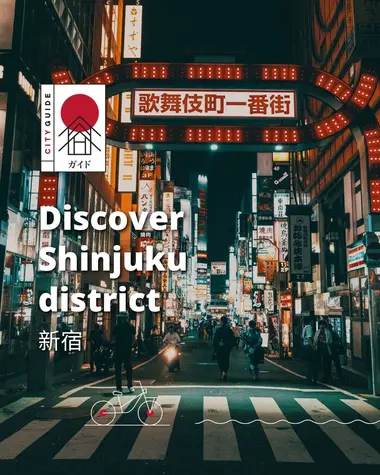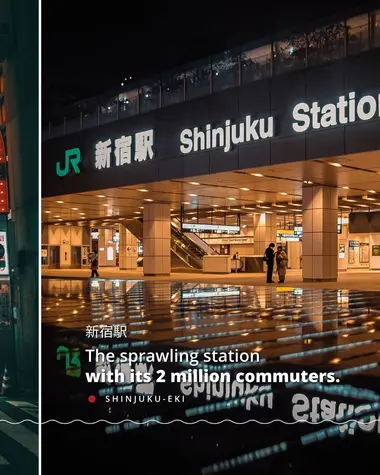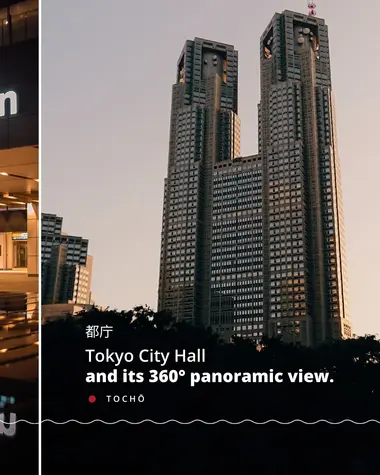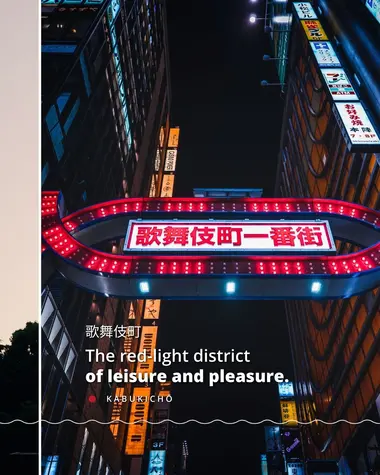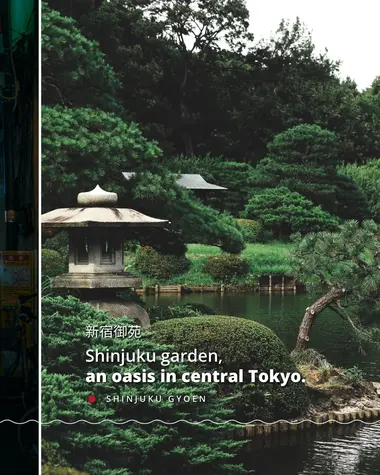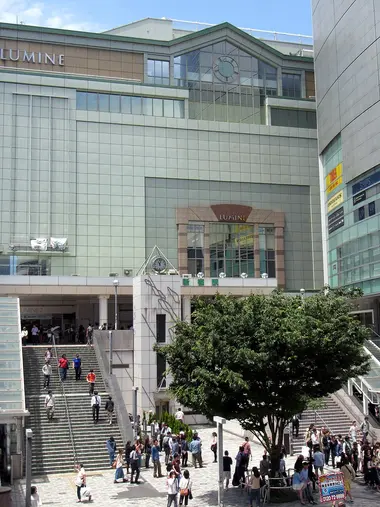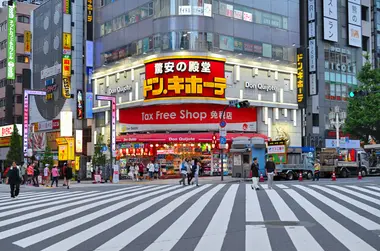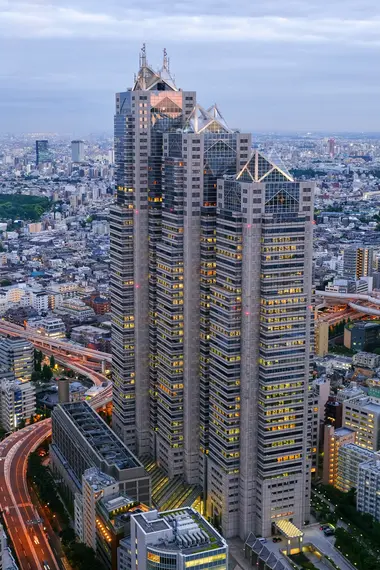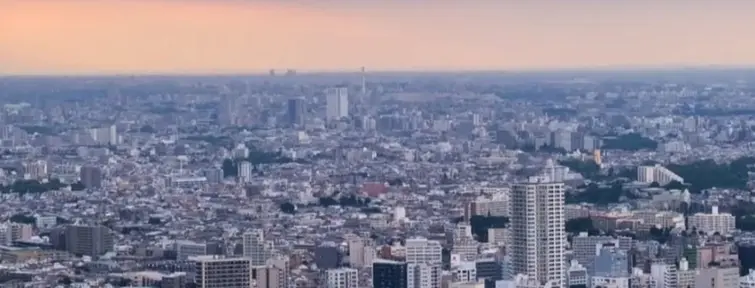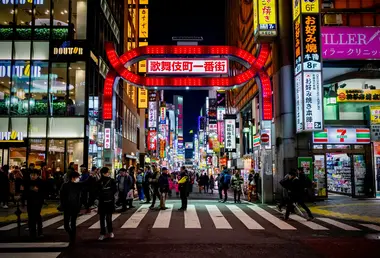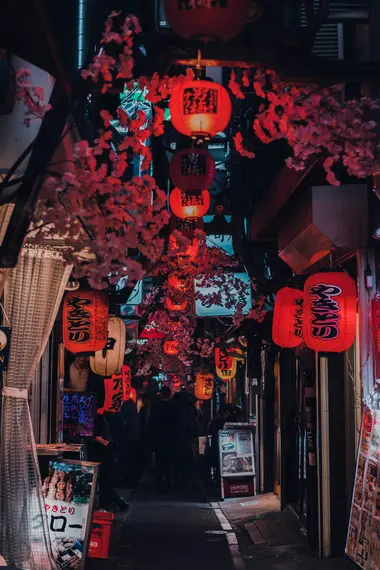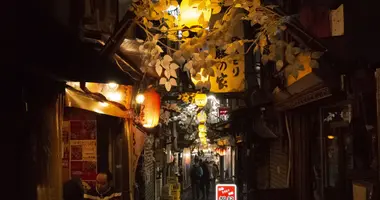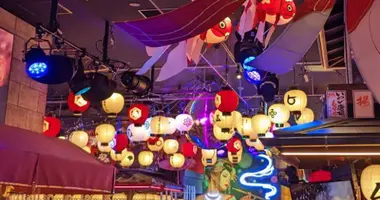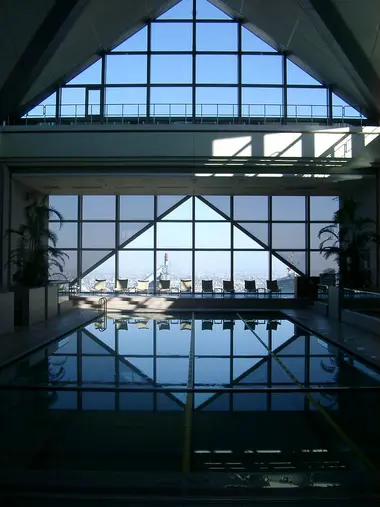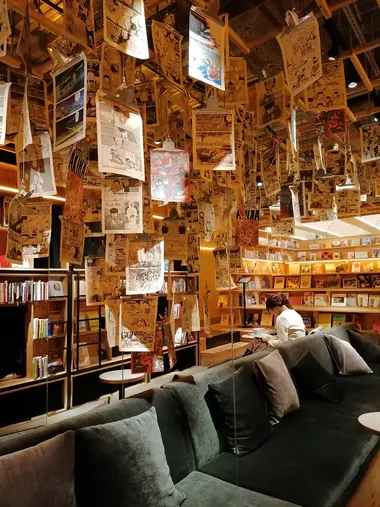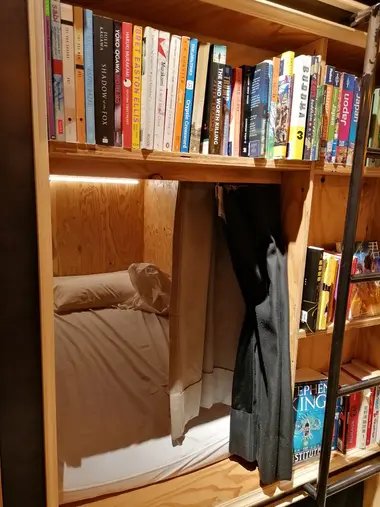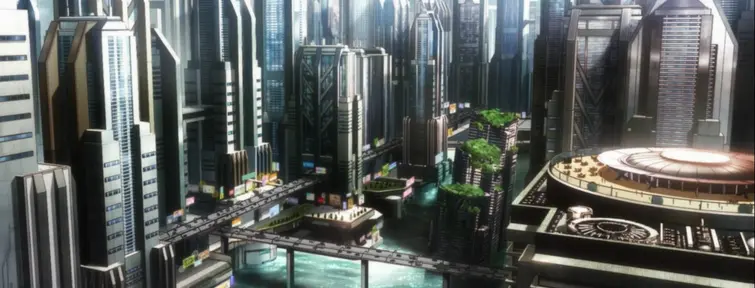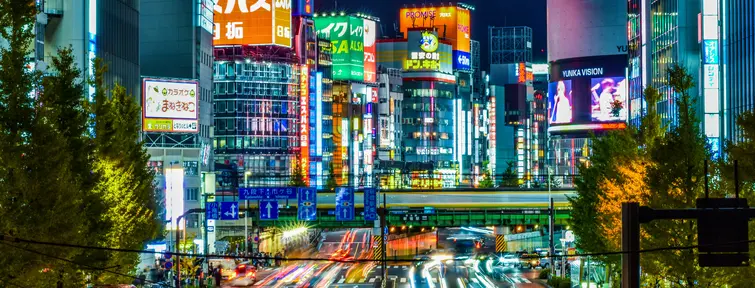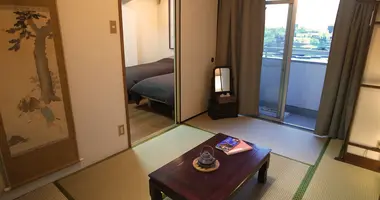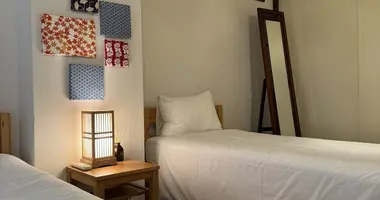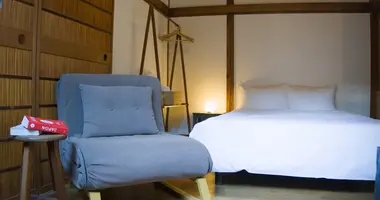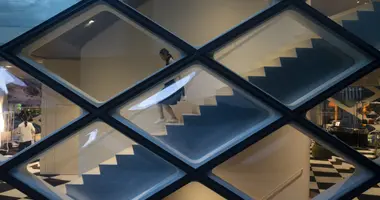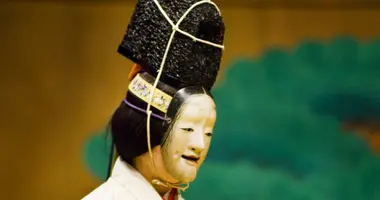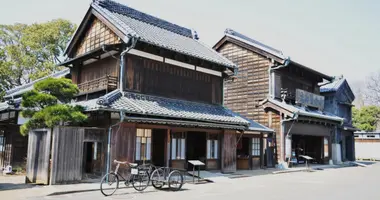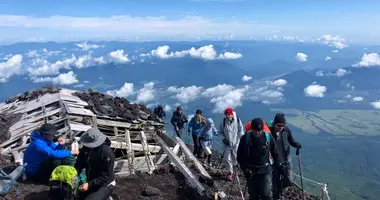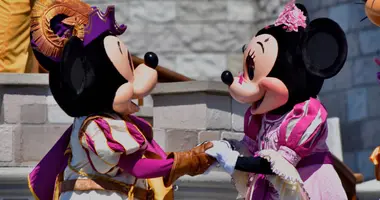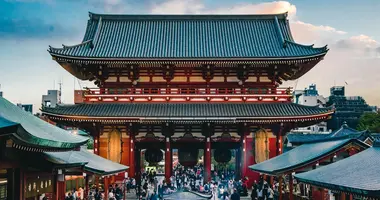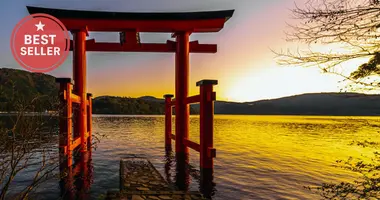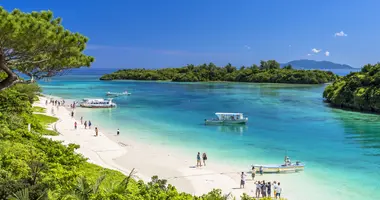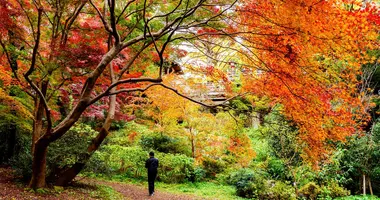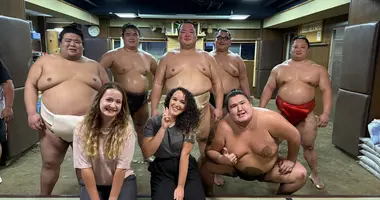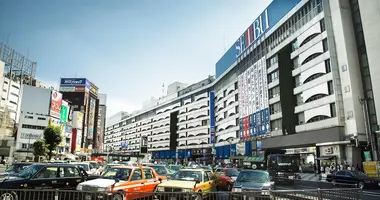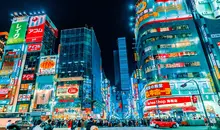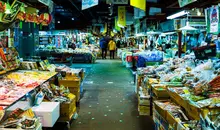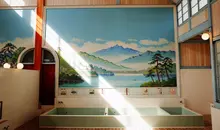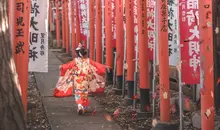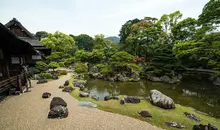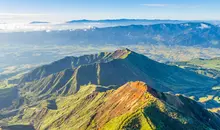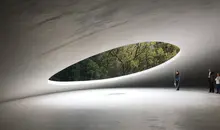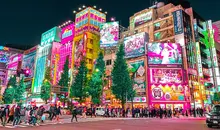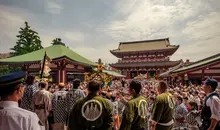Shinjuku- a dynamic city center filled with people and culture
- Published on : 04/04/2018
- by : J.L.T.B.
- Youtube
With its high-reaching skyscrapers and multi-floored department stores, Shinjuku is a dynamic hub of commerce and commute within the Japanese capital. But there's much more to the district than what many may believe. Gardens, cafés, and hotels of all kinds—Shinjuku's charm lies in its eccentricity. Follow our guide around the district of a thousand faces!
What to see, what to do
Parks and greenery
Although located within the heart of Tokyo, Shinjuku boasts a number of green spaces that can be enjoyed at any time of year.
This is one of Tokyo's most beautiful parks. Originally reserved for the imperial family, it has been open to the public since 1949. The park comprises three distinct sections, each with its own undeniable charm: the Japanese garden with its tea pavilion, the French garden and the English garden, famous for its large expanses of lawn. Prized in spring for its cherry trees, Shinjuku Gyoen is also very popular in autumn when the leaves turn red. Picnics are permitted, as are pets on a leash.
- Shinjuku Chuo Park
Less well-known than Shinjuku Gyoen, Shinjuku Chuo Park is a green oasis amidst the buildings of the western part of the district. A pleasant place to picnic, it's best known for its small cafes. We suggest checking out Musashino Mori, a chain of cozy cafes offering a wide range of drinks and affordable dishes.
A place steeped in tradition
You will come across several temples and shrines in the streets of Shinjuku.
- Hanazono-jinja
This is Shinjuku's most famous shrine. Located near Kabukichō, it is dedicated to the god of prosperity and hosts several festivals throughout the year, such as Tori no Ichi in November. Visitors can pray to the gods for good luck and purchase kumade, decorative rakes believed to bring prosperity in business.
- Kishimojin-dō
Close to the Okubo district, this small Buddhist temple is dedicated to Kishimojin, protector of children and childbirth.
- Naruko Tenjin-jinja
Founded in the 10th century, the shrine is dedicated to Tenjin, the god of learning. There is also a small artificial hill, resembling Mount Fuji.
- Shinjuku Juniso Kumano-jinja
Founded during the Muromachi period (1336-1575) in Shinjuku Chuo Park, this shrine is traditionally visited at the beginning of the year to seek divine protection.
- Taiso-ji
This Buddhist temple of the Jōdo school is famous for its Buddha and impressive statues.
See Tokyo in a whole new way with an expert guide to the capital of Japan!
Would you like a tour around Tokyo with a local expert? Our guided tour is for you!
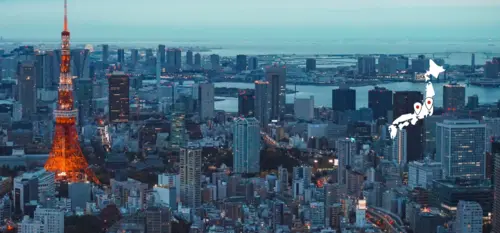
A major shopping center
Feel like maxing out your credit card? Shinjuku is the place to be.
Shopping centers
- Isetan Shinjuku: Shinjuku's iconic department store. Isetan is renowned for its high-end fashion and its basement food hall (depachika).
- Takashimaya Times Square: A vast complex directly connected to the station, combining fashion, lifestyle, bookstores, and restaurants. From the rooftops, it offers an interesting view of Shinjuku Station.
- Lumine (Lumine 1, Lumine 2, Lumine EST): A series of trendy malls connected to the station, very popular with young people, with fashion boutiques and cafes.
- Odakyu Department Store: A classic department store, convenient for fashion, homewares, and gourmet food.
- Keio Department Store: A department store directly connected to the station, famous for its depachika.
- NEWoMan: A modern and chic shopping mall focused on lifestyle, food, and women's fashion.
- Shinjuku Marui (OIOI): The shopping center comprises several buildings (Marui Men, Marui Annex, etc.) focused on fashion and lifestyle.
Shopping streets
The area around the station offers a wide choice of stores of all kinds. Here are a few must-sees:
- Don Quijote Shinjuku: THE temple of offbeat discount shopping. Open 24 hours a day, the chain is perfect for bringing home unusual souvenirs.
- Bicqlo (Bic Camera + Uniqlo): when two Japanese giants meet, the result is an astonishing mix of high-tech and clothing.
- Yodobashi Camera: a must for photo and electronics enthusiasts!
- Kinokuniya Shinjuku: a huge Japanese bookstore with an international section.
- Tokyu Hands (in Takashimaya): the perfect place to find stationery, DIY items, and gift ideas.
A street photography paradise
Just walking around the streets of Shinjuku is enough to take in the sights.
Interesting architecture
Designed by Tange Kenzō, the building features two futuristic sister towers, inspired by Gothic cathedrals. You can go to the observatories on the 45th floor free of charge.
- Mode Gakuen Cocoon Tower
This cocoon-shaped building is one of Shinjuku's symbols. It is home to fashion, design, and IT schools.
- Shinjuku Park Tower
Designed by Kenzo Tange, this building complex comprises three asymmetrical towers. The top floor houses the Park Hyatt Tokyo Bar, made famous by the film Lost in Translation.
- Kabukicho Tower
With its 48 floors and 225 meters in height, this is Japan's tallest skyscraper dedicated exclusively to leisure. It features two hotels (including the Hotel Groove Shinjuku), restaurants, bars, concert halls, cinemas, a theater, arcades and even an e-sports area.
- Shinjuku Sumitomo Building
Built in 1974, the building stands out for its empty triangular atrium in the heart of the city—a technical feat at the time.
- Shinjuku NS Building
The building surprises with its clock suspended outside.
- Sompo Japan Head Office Building (formerly Yasuda Kasai Kaijo)
The 200-meter-high skyscraper is known for housing the Seiji Togo Museum, where one of the five versions of Van Gogh's Sunflowers is on display.
Observatories with breathtaking views
- Tokyo Metropolitan Government Building
The building has two observatories (North Tower and South Tower) over 200 meters high, offering panoramic views of Tokyo and even Mount Fuji! Admission is free, but the line to access the elevators can sometimes be long.
- Shinjuku Sumitomo Building
This is the editorial team's little secret. On the 51st floor, the building offers a beautiful view of Tokyo, especially in the evening.
Christmas lights
- Shinjuku Terrace City Illumination
This is the most iconic event in the neighborhood. It stretches from the west exit of Shinjuku Station to Takashimaya Times Square. Every year, from mid-November to February.
- Shinjuku Southern Terrace
The illuminations south of the station offer a romantic stroll, with trees decked out in fairy lights.
- Takashimaya Times Square & NEWoMan Shinjuku
The shopping centers are adorned with giant Christmas trees and festive window displays.
Unique neighborhoods
In addition to its shopping streets, there are two districts that stand out when you think of Shinjuku.
Located east of Shinjuku Station, this is Japan's largest nightlife district. Bars, izakaya, clubs, pachinko, karaoke, cinemas, hotels—you name it, Kabukicho has it! Known as Tokyo's “red-light district” because of the hustlers who work there for the surrounding hostess bars, it is frequented by tourists who appreciate its unique atmosphere, made up of neon lights and unusual landscapes. The latter include Godzilla's head above the Toho Cinema and Kabukichō Ichibangai, the large red arch at the entrance to the district.
Located in eastern Shinjuku, a stone's throw from Kabukichō, this district boasts over 300 LGBTQ+ establishments, from intimate bars to festive international clubs. An emblematic place for queer culture in Japan, Tokyo Rainbow Pride has its roots here, as did the first associations defending the rights of the LGBTQ+ community.
Where to eat?
With over 3,000 cafes and restaurants, Shinjuku is the Tokyo district with the largest number of food outlets in the city.
Endless restaurants
- Shinjuku-sanchome
Just a stone's throw from Shinjuku Central Station, the Shinjuku-sanchome district is home to an impressive number of cafes and restaurants. One of the editors' favorites is the Wall Cafe, offering excellent value for money for those wishing to sample seasonal dishes in the warm atmosphere typical of trendy Japanese cafes.
- LUMINE's food court
The top floors of the mall are home to some 15 restaurants, serving both Japanese and Western cuisine. Our recommendation? T's Tantan, a vegan ramen restaurant.
- Luxury hotels
You don't have to stay at a luxury hotel to enjoy its cuisine. Whether for brunch, lunch, or dinner, these high-end establishments offer a variety of menus to savor while admiring Tokyo from the city's highest floors. The best part? Afternoon teas, which are very popular in Japan, allow you to enjoy sweet treats for a few hours thanks to themed buffets that change with the seasons.
- Our recommendations:
Nabezo: Offering high quality, all you can eat nabe and sukiyaki, be sure to come hungry!
Sushi-Yama Shinjuku: Indulge in the outstanding seafood of Hokkaido!
Hokkai Monja × Teppanyaki KIBORI Shinjuku: This restaurant combines the distinct nature of monjayaki (a Tokyo specialty akin to okonomiyaki) with teppanyaki dishes.
Want to try your hand at making authentic Japanese cuisine? Check out our sushi workshop in Shinjuku!
Learn to prepare sushi and cook other delicious Japanese dishes!
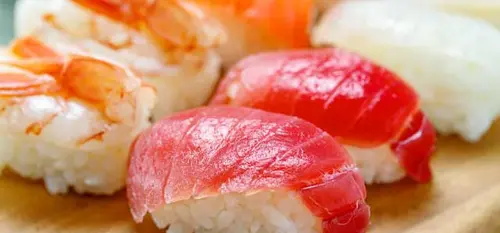
Set of sushi
A district filled with izakayas
While Shinjuku is full of traditional bars, two places stand out for the number of izakayas ripe for discovering!
The Golden Gai is one of Shinjuku's most emblematic venues. Retro to perfection, it'll take you back to post-war Tokyo. Stroll along its narrow streets, lined with over 200 bars. Each bar has a specific theme (cinema, jazz, etc.) and a maximum seating capacity of ten. Yakitori skewers, sake and appetizers—there's no better place to get introduced to izakaya culture!
Our recommendations:
Bar Albatross: Famous for its eclectic decor (chandeliers, works of art) and warm ambience.
Champion: An iconic Golden Gai karaoke bar, beloved for its festive atmosphere.
La Jetée: Inspired by French cinema, this intimate venue is a meeting place for film lovers.
Literally “the alley of memories,” Omoide Yokocho is a picturesque alley near Shinjuku Station. It's famous for its tiny izakaya, yakitori stalls and ramen stands, where people eat shoulder-to-shoulder in a friendly, smoky atmosphere.
Discover Shinjuku in the evening with an English-speaking guide!
Where to stay?
Shinjuku offers a wide range of accommodation. It's a top choice for anyone looking for a convenient, central base from which to explore the city.
Luxury hotels
- Kimpton Shinjuku
- Park Hyatt Tokyo
- Hyatt Regency Tokyo
- Hotel Century Southern Tokyo
- Keio Plaza Tokyo
- Bellustar Tokyo
- Hotel Groove Shinjuku
- Hilton Tokyo
- Hotel Gracery Shinjuku (with Gozilla theme room)
Some unique recommendations
- Book & Bed Shinjuku
Who hasn't dreamed of sleeping among books? At Book & Bed, capsule rooms open onto a huge library. Whether for a siesta or an overnight stay, this place is well worth the detour. There are also more traditional rooms and a cafe area, open to all.
- Nine Hours Woman Shinjuku Sleep Lab
This high-end capsule hotel is for women only. In a modern, uncluttered style, it is designed around three essential moments for travelers: showering, sleeping and getting ready. An attractive, economical alternative for solo female travelers.
- Yuen Shinjuku
A ryokan in the heart of the city? Yuen Shinjuku will win you over with its traditional, elegant ambience. The views from the rooms are breathtaking. You'll also appreciate the rooftop hot spring.
Looking to rent a home for accommodation? Discover our house in Nakano, 5 minutes by train from Shinjuku.
Located in Nakano, 5 minutes by train from Shinjuku, our Hinoki House is ideal for those who prefer the comfort of a private home to a hotel.
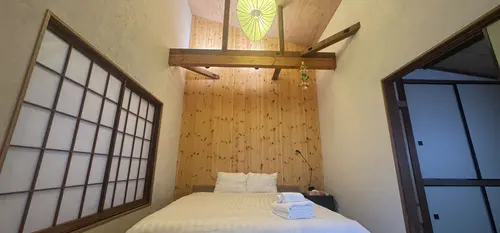
Shinjuku in history and pop culture
The name “Shinjuku” means “new inn.” And with good reason: in the 17th century, the neighborhood was an important stop on the Kōshū-kaidō road (one of the 5 great Edo roads). With its inns and shops, it was a popular stopping-off point for travelers. Over the centuries, the district grew to house ever more shops and restaurants.
After 1945, Shinjuku became home to black markets and underground bars, giving rise to popular areas such as Omoide Yokocho and Golden Gai. Twenty years later, the district was modernized and its first buildings were erected. It wasn't until 1991, with the inauguration of the Tokyo Metropolitan Government Building, that Shinjuku definitively regained its letters of nobility and became the heterogeneous, urbanized district we know today.
As a Tokyo landmark, Shinjuku is often depicted in popular culture.
- Lost in Translation: The Shinjuku Park Tower and its top-floor bar are a key location in the film.
- Godzilla: Godzilla's famous head towers above the Toho cinema in Kabukichō in commemoration of his role in Japanese pop culture and film.
- Tokyo Drift (Fast & Furious: Tokyo Drift) and other action films often use Shinjuku as the backdrop for nighttime chases.
- The anime Akira, Ghost in the Shell and Psycho-Pass show futuristic visions of Tokyo, with neighborhoods inspired by Nishi-Shinjuku and Kabukichō.
- Studio Ghibli productions: Some scenes take place in real-life Shinjuku.
For more information on Tokyo, be sure to check out our newsletter and Instagram!

